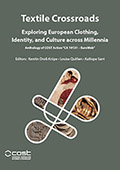Center, Textile Research

Textile Crossroads: Exploring European Clothing, Identity, and Culture across Millennia
Date of this Version
2024
Document Type
Article
Citation
In Textile Crossroads: Exploring European Clothing, Identity, and Culture across Millennia. Anthology of COST Action “CA 19131 – EuroWeb”. Kerstin Droß-Krüpe, Louise Quillien, & Kalliope Sarri, Editors. Zea Books, Lincoln, Nebraska, 2024. DOI: 10.32873/unl.dc.zea.1806
Abstract
Organic dyes have been used from the earliest times to provide color primarily to textiles, but also as a colorant in painting. Such organic dyes could create a wealth of colors, depending on the availability and know-how of resources. These dyes are usually organic in nature, and primarily obtained from different plant sources. Unfortunately, the characterization of natural organic colorants in textiles and artworks is still a challenge. The difficulty of analyzing these materials is sometimes allied to the frequent impossibility of micro-sampling, and the frailty of the objects. Many techniques, such as HPLC (High-Performance Liquid Chromatography) and SERS (Surface-Enhanced Raman Spectroscopy), require the use of a micro-sample, which cannot be recovered after analysis. Moreover, the portable technique Fibre Optic Reflectance Spectroscopy (FORS) can present some challenges in distinguishing between different dye sources belonging to the same molecular family, such as anthraquinone reds. Although no one technique alone can unravel the world of natural dyes, a multi-analytical approach has proven to be far more effective for their identification and characterization.
In the present article, we intend to share insights into three different perspectives and types of source material for the study of the use of organic colorants in ancient and historical times: The first case study presents an 18th-century historical recipe for dyeing textiles, the second case study presents a study of preserved archaeological textiles from Nubia, while the third case study presents the use of organic colorants for the polychromy of ancient Greco-Roman iconography.
Included in
Ancient History, Greek and Roman through Late Antiquity Commons, Archaeological Anthropology Commons, Classical Archaeology and Art History Commons, Classical Literature and Philology Commons, Eastern European Studies Commons, European History Commons, European Languages and Societies Commons, Fiber, Textile, and Weaving Arts Commons, History of Science, Technology, and Medicine Commons, Human Geography Commons, Museum Studies Commons, Place and Environment Commons, Social and Cultural Anthropology Commons, Women's Studies Commons


Comments
Copyright © 2024 by the authors.